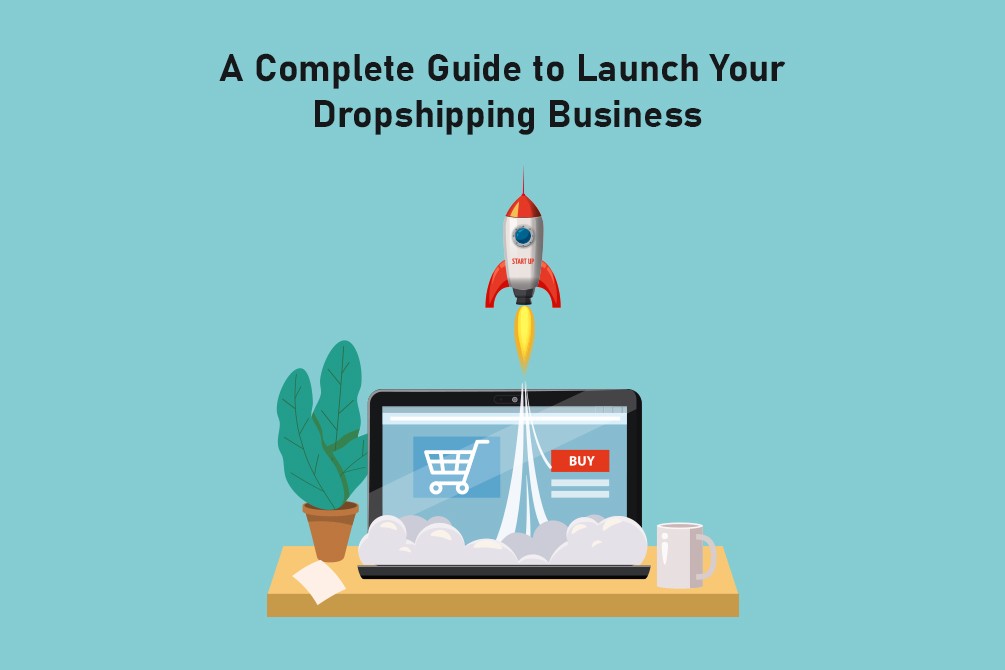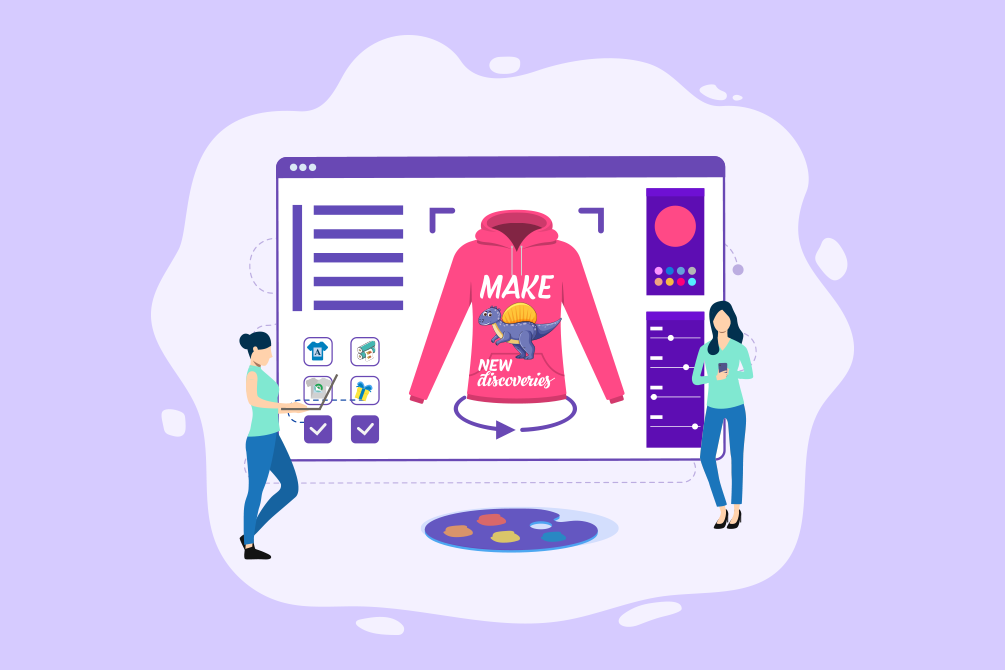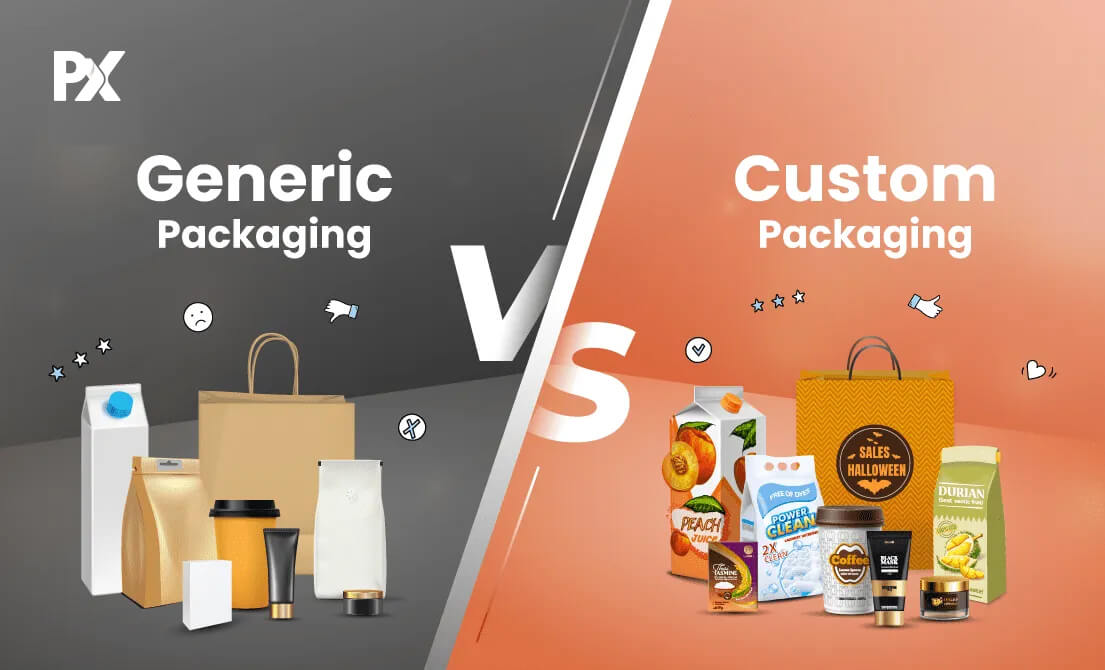- Summary
- Find a Product That Will Always Be in Demand
- Partner with a Reliable Dropshipping Supplier
- Create and Launch an Online Store
- Build a Strong Brand by Personalizing Customer Experience
- Product Returns: Handling Supplier’s Errors Like A Pro
- Have a Solid Marketing Strategy for Your Dropshipping Business
- Frequently Asked Questions About Starting Online Dropshipping Business
Summary
Less capital, no inventory, and no headache with shipping.
That’s what makes dropshipping a great business model for aspiring entrepreneurs.
The growing popularity of this model has led to a 23.7% surge in the worldwide drop shipping industry which will reach a value of $243.42 billion by 2023.
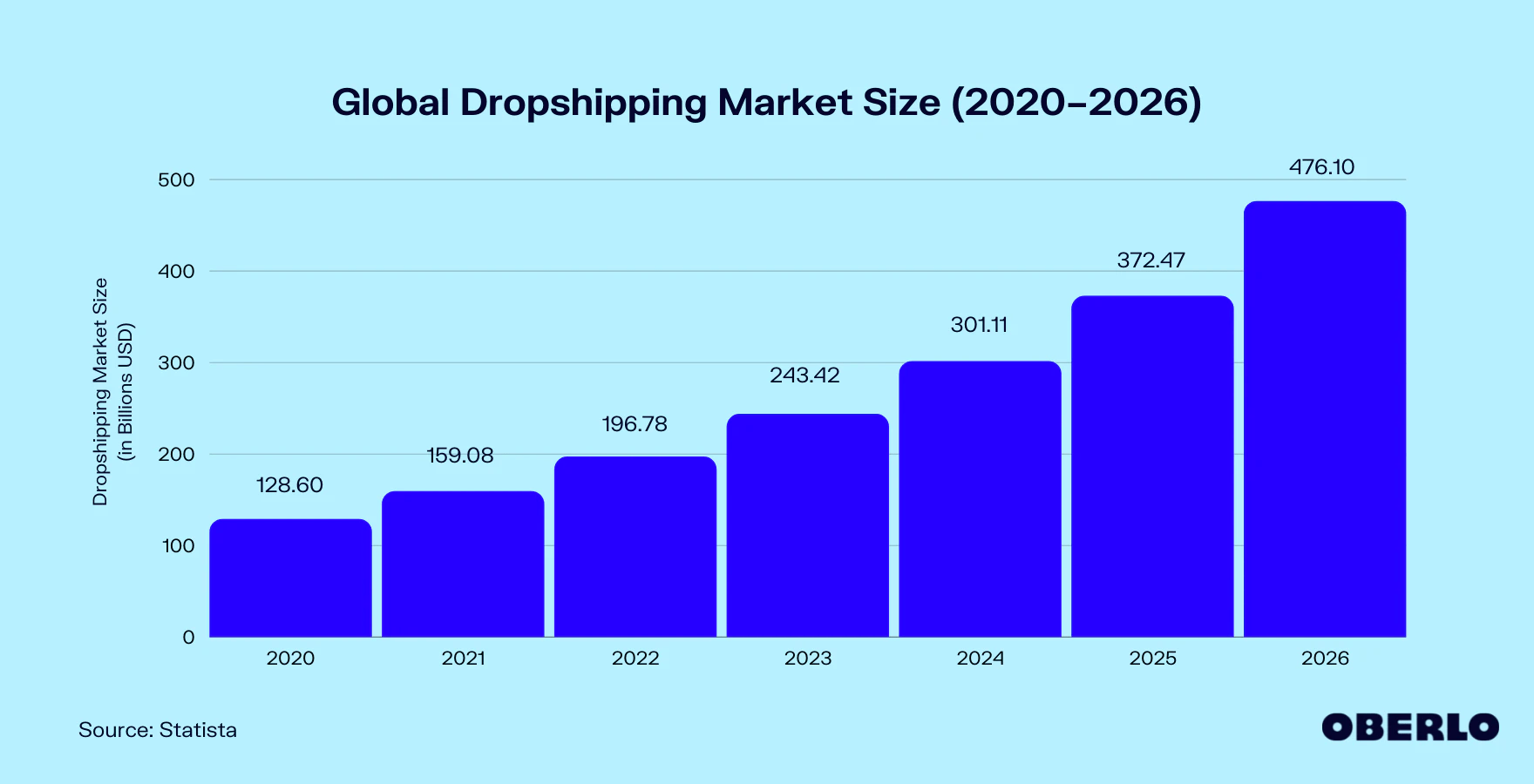
For instance, there are chances of mishaps because you are dealing with third-party providers. If a supplier fails to execute an order, customers will point the finger at you.
Secondly, your customers aren’t simply buying a product. They look for trust, your marketing, overall branding, etc.
For that, you need a foolproof dropshipping business plan. A plan that helps choose the right products, find reliable suppliers and ultimately build a successful dropshipping business.
To help you, we have prepared this post that covers all the right information you need on how to start drop shipping business.
Find a Product That Will Always Be in Demand
First-time entrepreneurs are just one product away from changing their entire life. If you want to build a long-lasting business, you want to choose products that will always be needed.
That’s what multi-millionaire entrepreneur Anthony Agyeman has to say about choosing a product. Anthony is currently dominating the high-ticket drop shipping industry and helps other business owners start a drop-shipping business.
He even suggests avoiding fads. They can be great for a couple of months but probably won’t even last a year.
For instance, if you remember slap bracelets, they were a phenomenon in the late 90s. But soon its demand decreased. Hence, the idea is to choose evergreen products.
Anthony believes that by choosing evergreen products, you can sell what people already want to buy. That way, you do not have to put too much effort into convincing them to buy.
Places to Research Dropshipping Product Ideas
Google is the first place to check products. When searching on Google, keep an eye on ads at the top, suggested searches, and Google shopping results.
To start dropshipping business ideas, you can also look for products based on search queries people use, the number of searches per month, and overall competition. This approach does require a basic understanding of SEO and keyword research. But luckily, there are plenty of tools that you can use.
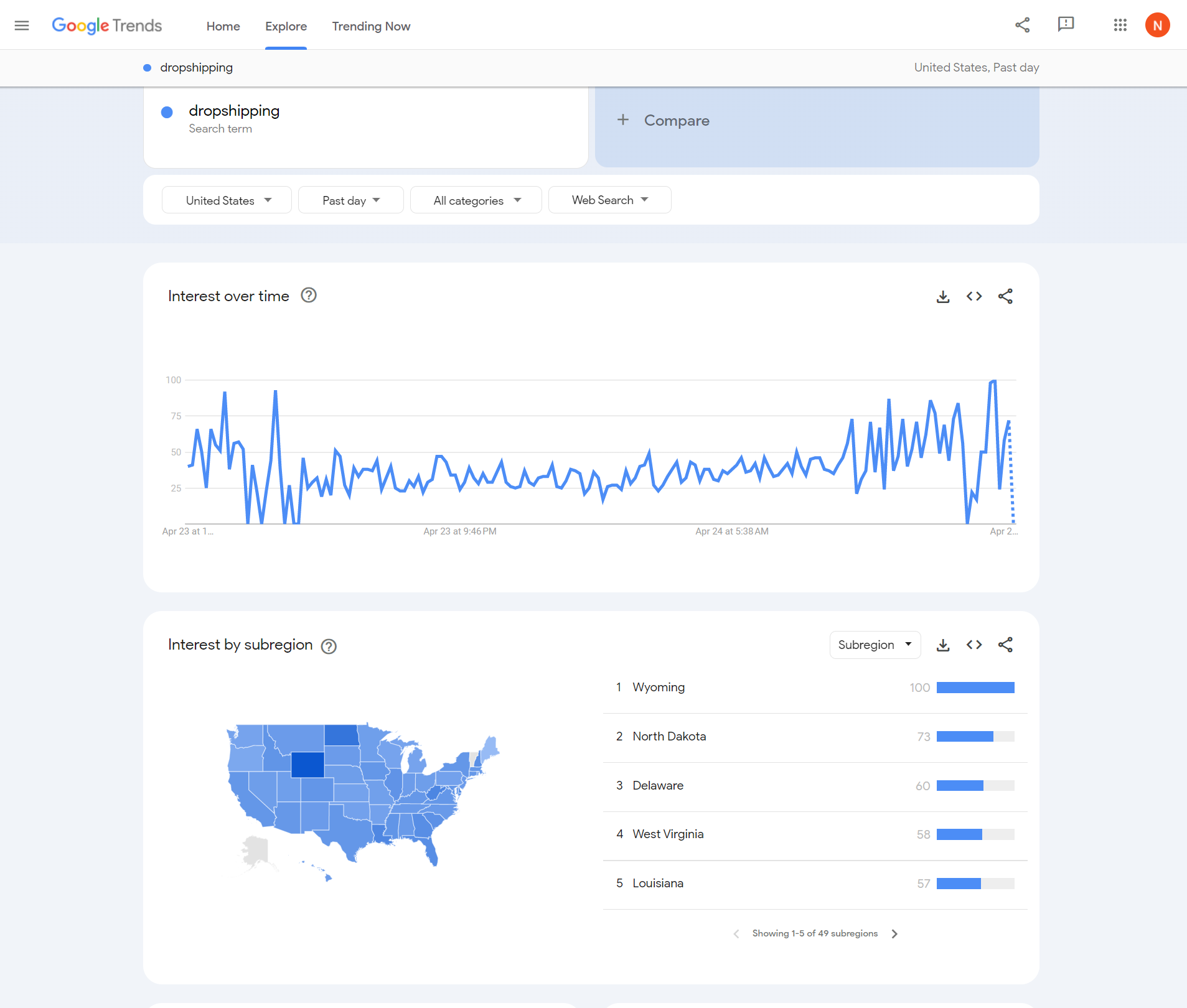
Using Google Trends, you can find out what trending dropshipping business ideas globally and regionally and even compare the demand for different products. To find search volume and related keywords to your chosen phrases, you can take the help of Google Keyword Planner.
Another place to find dropshipping product ideas is B2B and B2C online marketplaces. Platforms like Amazon, eBay, Alibaba, etc., are a goldmine for product ideas. You can browse these websites and check ‘most wished for, ‘best-selling,’ and other categories to get insights on customer demand.
Consider looking for products that are currently trending. If you can get trending dropshipping products to your store before your competitors, the chances are that you can establish yourself as a leader in that category.
Websites like Oberlo, Shopify, etc., keep updating their list of trending products. You can check their blogs to see what’s in demand and make a list of products with huge profit potential.
In your search for finding dropshipping business ideas, consider targeting a niche market. Niches that have a high potential will help you gain a competitive advantage in the market.
It is tempting to enter a niche that you find interesting and are passionate about. But there is hardly any logic in choosing a niche with no competition.
For example, Oberlo recently documented a case study where an entrepreneur’s pineapple store (hats and bracelets with pineapple print) failed, but his watch business made nearly $7000 in 8 weeks.
Start selling products that your customers can design. Check out how a product customization tool works for your dropshipping business.
A Golden Combination to Create Best Selling Products
Once you have a list of products, you need to find a way to be better and smarter than your competitors. Solving a customer problem is always an effective way to create a product that sells. Uber wouldn’t be so popular if getting a taxi wasn’t a frustrating experience.
Think of how your business can make an existing product better. Online customer reviews are a great way to find customer pain points. Shoppers often share their views about what a product lacks and how it can be improved.
Another way to identify customer pain points is to have a look at your competitor. Evaluate their website, especially their FAQs, product descriptions, etc. Check for pain points that you might have missed and if you can incorporate them.
Product customization is another way to offer great products to your customers and build a successful dropshipping business. And that is why brands are enabling customers to take an active part in the product creation process.
Customization not only strengthens the user experience but also creates a better opportunity for conversions.
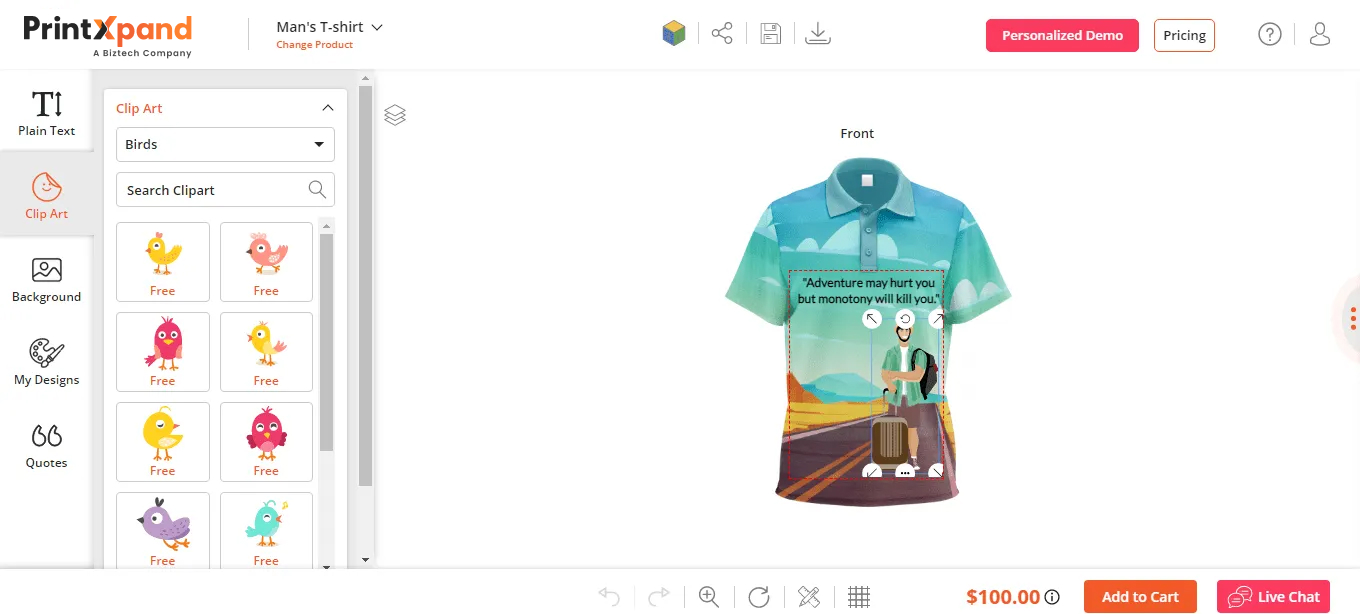
(All-in-one Product Designer Tool)
Tools like a product designer tool can enable your customers to design your products the way they want. Our fully functional product design tool comes with a pool of features that make product customization super easy for your customers.
Tool features include font manager, image preview, clipart library, image upload, object management, image filters, to name a few. Whether you are selling mobile covers or shoes, our tool works on any product with a printable surface.
There are several benefits that you too enjoy as a business owner. Our tool is fully customizable. You can change it as per the theme of your brand. As an admin, you have control over what products shoppers can customize. You can decide on a design area, set text and image configurations, and more from the backend.
Start dropshipping business with an added USP of product customization. Explore all the features of our tool now.
Partner with a Reliable Dropshipping Supplier
When you start dropshipping business, one of the most important decisions you have to make is choosing the right supplier. A supplier is at the core of dropshipping model since they hold inventory and ship products to your customers.
As for customers, they do not know you are not the one producing, packaging, or shipping their products. So, if the supplier messes up with anything, customers will hold you accountable, and hence it’s crucial to partner with suppliers who are genuine and trustworthy.
However, genuine suppliers are hard to find. When you search for suppliers, you will find many fake ones.
How to Spot Fake Dropshipping Wholesalers
When dropshipping personalized products, these tactics will help you know whether a supplier is legitimate or not.
Are they asking for monthly fees?
If a supplier asks for a monthly membership or a service fee, then it’s a sign they might not be legitimate. Real wholesalers will not charge a monthly fee for doing business with them. However, note that there are legitimate dropshipping fees that you need to pay, like pre-order fees.
Do they refuse to sign a contract?
Genuine wholesalers will always ask for proof to check if your business is legal. They reveal their pricing only to approved customers and sign a contract. If you contact a supplier who refuses to sign a legally binding agreement, you need to look for other options.
Are they avoiding giving test samples?
Before you finalize a supplier, you will need to ask them to provide you with samples. Asking for samples is a common practice to check the quality of a product, and real wholesalers will indeed comply. Avoid dropshipping personalized products for a supplier who denies sending samples.
Does a supplier claim to help you make quick profits?
Usually, in dropshipping, the per product margin is low because a wholesaler manages several tasks on your behalf, requiring monetary resources. What fake drop shippers do is they will lure you by giving high-profit margins. Stay alert and do not fall into that trap.
Do they have poor reviews or ratings?
Before finalizing a supplier, it’s a good idea to check their reviews and ratings online. If you find negative feedback or poor ratings, it may be a sign that the supplier is not reliable. However, keep in mind that some negative reviews may be fake, so be sure to do your research carefully.
Are they transparent about their shipping and return policies?
A legitimate wholesaler should be transparent about their shipping and return policies, including any fees and timelines involved. If a supplier is vague about these details or refuses to provide them, it may be a sign that they are not trustworthy.
Places to Find Dropshipping Suppliers
1. Check (Obviously) Google
Most wholesalers hardly spend any time marketing. Hence, chances are you might not find good ones in the top results of Google. You will have to go through a lot of search result pages.
Also, it is good if you do not limit yourself to using phrases like ‘wholesalers for X’. For better results, include other keyword modifiers like bulk, suppliers, distributors, etc.
We tend to judge a business based on how its website looks. Some legitimate drop shipping wholesalers are known for having poor designs. Before you consider such suppliers unreliable, spend some time going through their websites.
2. Do not Forget AliExpress
AliExpress is one of the biggest online marketplaces to search dropshipping suppliers. AliExpress caters to retail buyers who want goods in lower quantities at factory prices. This is what makes the platform an excellent option for dropshipping.
You can find trading companies and smaller distributors. Moreover, with AliExpress, there is no upfront cost or fee. You can test out products without any financial commitment.
When searching suppliers, consider checking feedback scores. It shows a seller’s sales volume and feedback from other merchants. Aim for suppliers who have a feedback score of at least 2,000.
You do not want to decide just based on scores. To verify product authenticity, you can check the warranty in the ‘Seller Guarantees’ tab on their product page.
3. Use Oberlo
If you choose to build a Shopify store, Oberlo is for you. With Oberlo, you can import products from suppliers directly to your store.
Oberlo offers other features like automated pricing, auto-update inventory, track orders, and more. It allows you to browse the vast database of AliExpress and add products. If you want to change a supplier for a product, Oberlo even allows you to do so.
Once you create a list of potential suppliers, here are some factors for you to consider before deciding.
- No compromise on product quality
- Partner with a supplier who can deliver products quicker
- Order samples to compare different suppliers
Starting a dropshipping business and signing up with suppliers require you to be legal. Hence, get in touch with your lawyers for the required information.
Create and Launch an Online Store
Before you start dropshipping business, there are a few things to consider. The first is choosing a domain name for your business. You should discover more tips on how to buy a domain name that suits your business the best.
Think about how you want to market your website in the future and choose a name accordingly. Shorter names are shorter and memorable. You can use domain name generators like GoDaddy to simplify the process.
Next, you will have to decide on an eCommerce platform. The platform you choose will have a major impact on the way you conduct business. Every platform has its pros and cons, set of features, and functionalities.
It is a time-consuming process. But make no haste and do in-depth research because once you make a choice, it will be difficult to change later.
Take your dropshipping business idea online today! Get in touch with a team of experts ready to help you build and grow your business.
Build a Strong Brand by Personalizing Customer Experience
Beyond logo and name, your brand is a sum of what you stand for, what your customer service is like, etc. How customers perceive your brand and whether they want to spend money or not comes down to customer experience.
Today, personalized customer experience has become a top priority for brands. If you execute correctly, tailored experiences can help your business gain a competitive advantage.
Personalization pays off by yielding a 20% higher customer satisfaction rate and a 10-15% boost in sales and conversions. Two ways to successfully improve shopping experiences with personalization are:
Enabling Customers to Customize Your Products
Today’s customers are focused on their individuality. They choose products that reflect their identity and that make their lives easier.
And hence, brands are enabling customization of their products by letting customers design themselves. Shoppers get the opportunity to create their unique designs, including text, logos, images, etc.
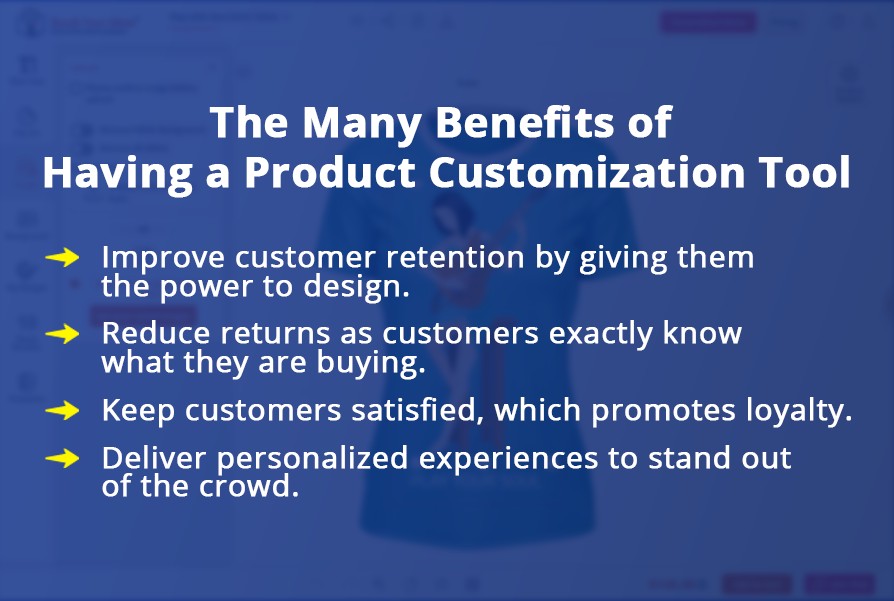
Luckily first-time entrepreneurs like you can boost customer experience and increase revenue quickly with the help of a product designer tool.
PrintXpand offers a ready to integrate product designer tool that is compatible with any eCommerce platform. Get in touch to see how enabling customization can heighten your brand experience.
Personalizing Website to Better Serve Prospects
Among the many benefits of personalizing a visitor’s website experience, below are the top ones.
- High converting landing pages
- Better converting calls to action
- Relevant product recommendations
- Personalized content to generate qualified leads
Personalization applies to every touchpoint of a visitor’s online journey. To find out where personalization can work for your business, you first need to identify your target audience. Look at your current visitor base, analyze what and why people buy from you, which type of audience is bringing in more business.
Second, identify the intent of the visitors. Look at the keywords they use to search for your products. By strategically incorporating high intent keywords in your site content, you can streamline the purchase journey and boost conversions. That will help you show site content that matches their intent.
Once you identify your target audience and understand visitors’ intent, you can focus on drafting content and messages you want your visitors to see.
Also, think of different web pages like home page, product pages, pricing pages, etc., where you want to implement personalization.
Interested in implementing web personalization for your business?
Check out PrintXpand’ web-to-print storefront solution to create a personalized website that better serves your prospects.
Product Returns: Handling Supplier’s Errors Like A Pro
Just like any other eCommerce store, returns also affect dropshipping businesses. Handling returns when you are not the one managing shipping? That sounds confusing.
But here’s the thing. Your end customers don’t know you are dropshipping. It doesn’t matter to them where a product comes from. They placed an order from your store, and hence you are responsible.
In your journey of running a dropshipping business, chances are, at some point, your supplier will mess up, leading your customers to return a parcel. One way to manage this is by creating a return policy.
Even more so as 67% of shoppers check a businesses’ return policy before making a purchase. Any good return policy page will include information like:
- If a return is free of charge
- Whether you offer an exchange for a product
- Countries or regions eligible for return and refund
- Time when products are eligible for returns
Below is the return policy by Rebel Girls. It clearly explains return requirements and shares contact information for further queries, and hence it works.

(Have a Clear Return Policy on Your Website Like This One)
Where you place this information on your website is equally important. Generally, customers look for information like FAQs, return policy, order policy, help section, etc., at the footer of websites.
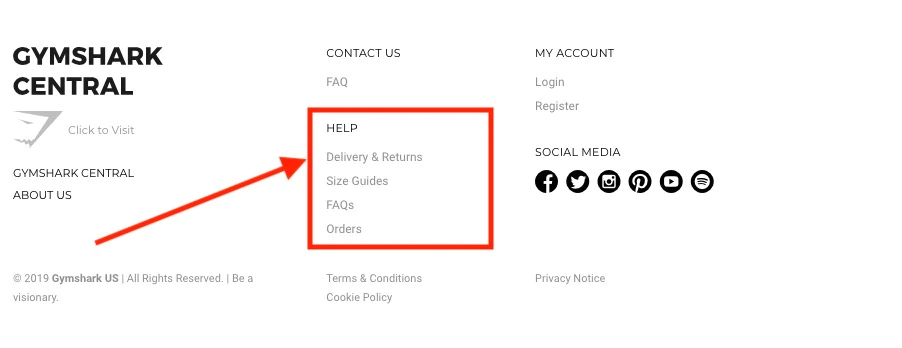
(Have an Easy-to-find Return Policy Page on Your Website – Image Source)
Additionally, tools like a product design tool can help you reduce returns since customers know what they are getting. Features like a 3D preview help them get a clear idea about how their purchase will look.
Enable faster purchasing decisions with a product designer tool. Request a demo to find out how.
Have a Solid Marketing Strategy for Your Dropshipping Business
Search Engine Optimization, consistent posting on social media platforms, cart reminder emails, etc., are few strategies entrepreneurs think about when promoting their store.
These are undoubtedly important and should be considered, but these alone are not enough. You have to broaden your vision and look for other ways to attract customers and double your sales.
Let’s have a look at three effective ways to market your dropshipping store.
Build Trust by Adding Customer Reviews
Customer reviews impact sales and conversion. And these statistics from Invesp are proof:
- 90% of consumers read online reviews before visiting a business.
- 88% of consumers trust online reviews as much as personal recommendations.
- Customers are likely to spend 31% more on a business with “excellent” reviews.
Reviews are one of the best ways to convert casual shoppers into customers. Shoppers who come for the first time on your website might be skeptical about your product and its quality.
Thus, adding reviews and ratings on your dropshipping store is an excellent way to build trust and encourage them to make a purchase.
Consider incorporating reviews on your product pages. For example, MVMT Watches use reviews on their product page to convince shoppers to buy. You can even place a ‘Write a Review’ feature on your store to encourage customers to leave a review.
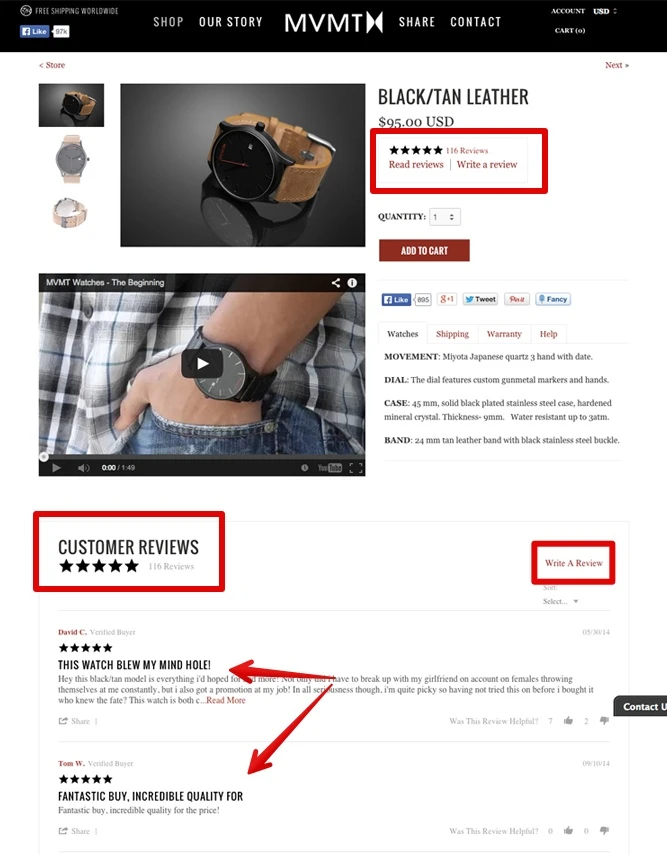
(Reviews on Your Product is an Effective Way to Build Trust & Encourage Shoppers to Place an Order – Image Source)
Implement Retargeting to Never Lose a Customer
Getting traffic and converting them is challenging. Visitors will come to your store but take no action. You need to bring them back, and that’s where retargeting helps.
Retargeting campaigns remind visitors about your products after they have left. You can retarget your visitors using Google ads, Facebook retargeting, and other advertising platforms.
Note that retargeting is for businesses that have a following of at least 100 visitors monthly. Once you start getting enough traffic, Google Ads is a good option for you.
You can even use Facebook Ads, but they are good only if your target users use that platform. Your ads won’t reach users if they are not on the platform. On the other hand, Google’s reach is broader, and ads are more customizable.
Not Just Market but Sell on Social Media
Social media users are increasing, and so are businesses’ opportunities to reach their target audience and sell.
It goes without saying that you will leverage social media platforms to promote your brand pre and post-launch. But you want to go a step ahead and sell your personalized products directly on social platforms.
Social commerce allows customers to purchase your products without leaving a platform. They can do so either by clicking on a paid ad or ‘View Shop’ CTA on your brand’s page.
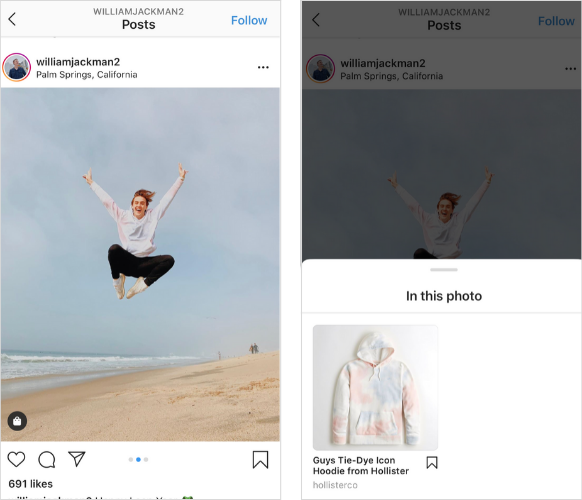
(Sell More with Social Commerce on Platforms Like Instagram – Image Source)
At the moment, platforms like Facebook, Instagram, Pinterest, and Snapchat offer social commerce. You can begin with a social commerce strategy on a platform where your target audience is active.
Build a loyal audience that keeps growing with our digital marketing services.
Launch Dropshipping Business Today with the Right Tech Partner
Successfully running a dropshipping business is a continuous process. You have to continue updating your website, experiment with trends that bring the desired outcome, and always stay on top with your customer service.
PrintXpand can be your reliable tech partner who will help you build, sustain, and grow your business. For more than 14 years, we have been helping entrepreneurs build their dream store with the right tools and expertise.
We aim to bring print and personalization together with the help of tools like product designer tools and product configurators. Businesses rely on our print ERP solutions to streamline their business operations, including order management, print management, inventory, etc.
Let us assist you in launching a dropshipping business where you can provide product customization with the help of a designer tool.
Frequently Asked Questions About Starting Online Dropshipping Business
[display_faq]
FAQs
Is dropshipping profitable?
Yes, dropshipping can be profitable because of the nature of this business model. You do not have to manage manufacturing, inventory, or shipping, which saves you expenses, unlike the traditional model.
Choosing the right product and supplier, investing in good tools, and proper marketing will help boost your profit margin.
Will I have to purchase products to start an online dropshipping business?
No. One of the biggest advantages of dropshipping is that merchants do not have to hold any inventory. Your supplier handles everything. However, it’s good to order samples from the supplier before uploading a product to your store.
How much does dropshipping startup cost?
Any business requires investment. The dropshipping startup cost depends on your goals and things like eCommerce platform subscription, website development charges, marketing costs, and other tools that you purchase to manage your business operations.
If you want to offer customization on your store, you can check out the pricing for a product designer tool here.
What kind of products can I dropship?
Finding a product is tricky, and you will have to research a lot. The key is to find products that will always be in demand and allow your business to scale. Start a dropshipping business by selling personalized products with a product designer tool. Get in touch for more details.
What is a product designer tool, and how will it help my dropshipping business?
With a product designer tool, your customers can create designs and customize your products by adding text, clipart, images, etc. Offering product customization will give a major boost to customer satisfaction rate and thus improve sales.
Request a personalized demo to see how a product designer tool can work for your business.
Where do I find suppliers who dropship?
You can search for dropshipping suppliers on suppliers’ directory like SaleHoo, Worldwide Brands, Doba, etc.
Who will pay for the shipping costs?
Your drop shipping supplier usually pays for shipping costs on order. However, they will put the responsibility to set the price on you.
How do returns from customers work in dropshipping?
Return policies vary from supplier to supplier. Some suppliers will accept only certain items, while others might not accept at all. Therefore, it is good to understand return criteria before selecting a supplier. For your customers, you can share product return information on your website too.
